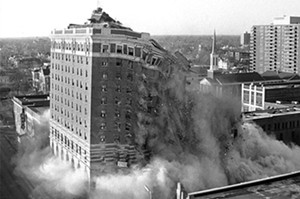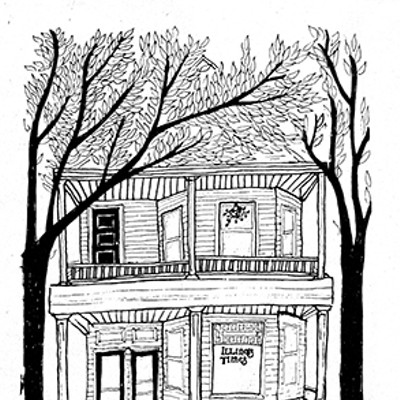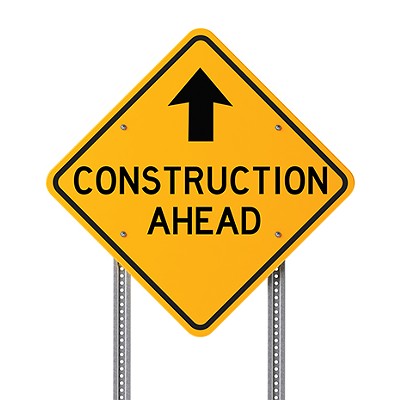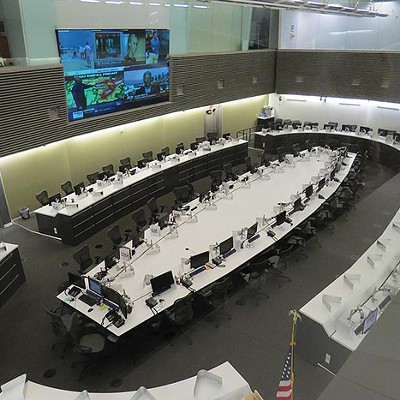
As part of our 40th anniversary observances, and in light of more recent events, we will revisit some of columns from James Krohe Jr.’s Prejudices series that ran from 1977 to 1994. Typos in the originals have been corrected and the pieces have been edited for length but they are otherwise unchanged.
Thirty-seven years ago this month, in a column that appeared in our paper of Dec. 22, 1978, I wrote an account of the demolition of the 52-year-old Hotel Abraham Lincoln at the corner of Sixth and Capitol. The hotel was razed to make room for a new state courts complex and legal education center which was never built, and that site remained empty to this day. On Dec. 14 Springfield’s economic development commission approved a roughly $125,000 contract with a consulting firm to advance the redevelopment of the old hotel site and the rest of that block.
At Fourth and Cook streets it looked like rush hour on a Monday morning. The curbsides which are usually vacant on Sunday mornings were crowded with cars, and the knots of people who got out of them moved briskly north toward downtown. It was the morning the state was going to blow up the Hotel Abraham Lincoln, and they’d all come to take a look.
L. and I joined the stream, slightly exceeding it in briskness, because it was already eight-fifteen and there were only 15 minutes before detonation. We, like everyone else on the street, had resolved to ignore the advice of authorities who asked sightseers to stay away. We headed west toward the knoll now occupied by the Illinois Bar Association headquarters and the attorney general’s building; it offered the perspective of height, and as the papers had said that the building would be taken down starting with the west wall, we reasoned (correctly) that the view from the west would be best.
We skirted police barricades by cutting through to Jackson Street along the driveway that runs between the Lincoln Towers apartment/hotel building and the Third Street railroad tracks. Partiers were crowding the balconies up and down the hotel side of the 14-story tower. They were shouting at people they knew below, laughing, singing; many were drunk. . . . The driveway was splattered with spittle, some of it showing traces of Bloody Marys, put there by the drunks on the balconies above, a few of whom were plainly trying to hit the people walking past them below.
The crowd on the ground was for the most part sober, quiet, a little tense. They looked at their watches a lot, occasionally tried to stamp the cold out of their feet, chatted, trampled on the lawyers’ ivy and shrubbery. One woman wondered aloud whether the pigeons roosting in the old hulk would have enough time to escape when the dynamite went off. Everyone, it seemed, had a camera strapped around his neck, something that puzzled me at first – pictures of the takedown would doubtless fill the pages of the papers the next morning – until I decided that a photograph taken on the spot was proof that the taker had really been there, his accreditation as a witness for anyone in the future for whom the taker might think it important to know.
L. and I watched with the rest (the papers said there were 5,000 in all) as the seven explosive charges cracked, like a tympani roll struck with hard mallets, and the Abe collapsed in an impossibly large cloud of dust. People clapped and left. A couple of hours later . . . lines of cars stretched down Capitol and up Fifth Street in a smoking processional, each car carrying sightseers past the ruins. . . .
For the rest of that day the memory of what I’d seen that morning replayed itself over and over. Something about it nagged at me, something familiar and strange at the same time. Then I remembered. I went to my bookshelves and took down my Orwell Reader and flipped to a memoir George Orwell wrote in 1936. He called it, “Shooting an Elephant,” and it was based on something that happened to him while he was serving in Burma with the Indian Imperial Police. He had had to shoot a rogue elephant that had killed a man. When he pulled the trigger, he wrote, he didn’t ever hear the report. Then:
“In that instant, in too short a time, one would have thought, even for the bullet to get there, a mysterious, terrible change had come over the elephant. He neither stirred nor fell, but every line in his body altered. He looked suddenly stricken, shrunken, immensely old, as though the frightful impact of the bullet had paralyzed him without knocking him down. At last, after what seemed a long time – it might have been five seconds, I dare say – he sagged flabbily to his knees . . . . And then down he came, his belly toward me, with a crash that seemed to shake the ground even where I lay.”
I reread the lines and put the book away. The sightseers, by the way, kept filing by the corpse of the Abe in long lines, until it got dark.
Contact James Krohe Jr. at [email protected].




















